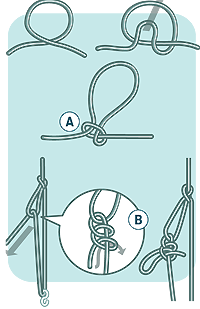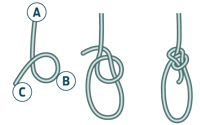Fit to Be Tied: Four Common Knots Every Hiker Should Know

(Photo: Thomas Barwick/Getty)
Are you one of those hikers who always defaults to a square knot? Here are simple, easy-to-remember alternatives that will do a better job in four common camping scenarios. The following knots will allow you to cinch, lash, and secure gear with ease.
Strap cargo to your car
To secure a canoe or duffel bag to a car roof or truck bed, you need a knot that acts like a pulley, so you can cinch down the load before you finish off the knot. The power cinch (also called the trucker’s knot) works best. Start by forming an overhand loop, pulling a loop through, and tightening (be precise: If you tie this knot backward, it won’t work). Next, feed the rope’s free end (A) around a roof rack or an S-hook on the bumper or frame. Tug on the working end to obtain the desired tension; then use a quick-release half-hitch (B) to “lock” the tension in place (and make untying cargo quick and simple).

Cinch tent guylines
Attached to webbing loops at key stress points on the outer walls of tents, guylines are tied to the ground with stakes or stones. They stabilize the tent in strong winds by keeping the fabric walls taut. When pitching your shelter, tighten the guylines until no slack remains in them or the tent walls. Fit the cords with a taut-line hitch, which lets you adjust the line’s length without untying the knot. When you move the knot by hand, it slides freely along the line, but it cinches tight when the loop is tensioned—so the knot holds firm when gusts tug on tent walls.

Lower a pack over a ledge
Some packs feature a sturdy strap above the harness for easy rope-hauls—but most require a bowline knot, which doesn’t slip no matter the weight. Slide the loop around the middle of the pack, tighten it, then lower away. The bowline is also ideal for hanging bear bags. A handy mnemonic: The rope’s long end is the “tree” (A); the loop is the “rabbit hole” (B); and the rope’s short end is the “rabbit” (C). To tie the knot, make the rabbit jump out of the hole, go around the tree, and dive down the hole.

Lash a canoe to shore
The clove hitch is perfect for quickly mooring boats because it’s easy to tie, holds fast under tension, and releases instantly with a tug on the free end. This makes it a speedy way to fix a line to a pier or tree. For extra security, add one or two half-hitches (A).
